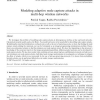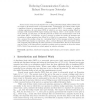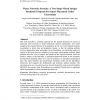92 search results - page 2 / 19 » Minimizing Expected Attacking Cost in Networks |
ADHOC
2007
13 years 5 months ago
2007
We investigate the problem of modeling node capture attacks in heterogeneous wireless ad hoc and mesh networks. Classical adversarial models such as the Dolev–Yao model are know...
IPL
2008
13 years 5 months ago
2008
Several recent research results describe how to design Distributed Hash Tables (DHTs) that are robust to adversarial attack via Byzantine faults. Unfortunately, all of these resul...
ICDCSW
2005
IEEE
13 years 11 months ago
2005
IEEE
An ad hoc or sensor network that is employed for security sensitive applications is expected to tolerate a certain quantity of maliciously behaving nodes. Algorithms must be desig...
CCS
2007
ACM
13 years 11 months ago
2007
ACM
Researchers have previously looked into the problem of determining if a given set of security hardening measures can effectively make a networked system secure. Many of them also...
CCE
2007
13 years 5 months ago
2007
This work describes a stochastic approach for the optimal placement of sensors in municipal water networks to detect maliciously injected contaminants. The model minimizes the exp...



